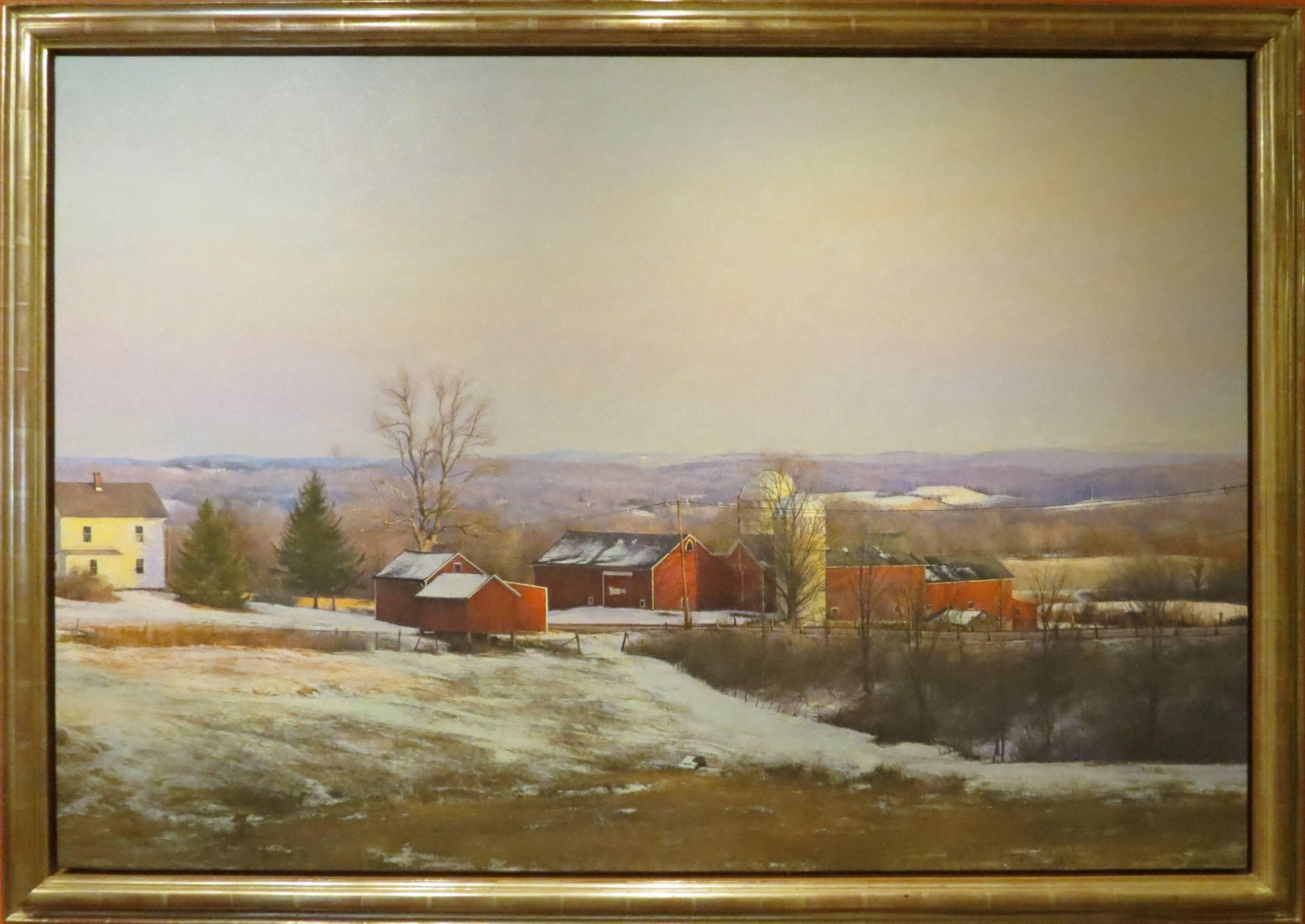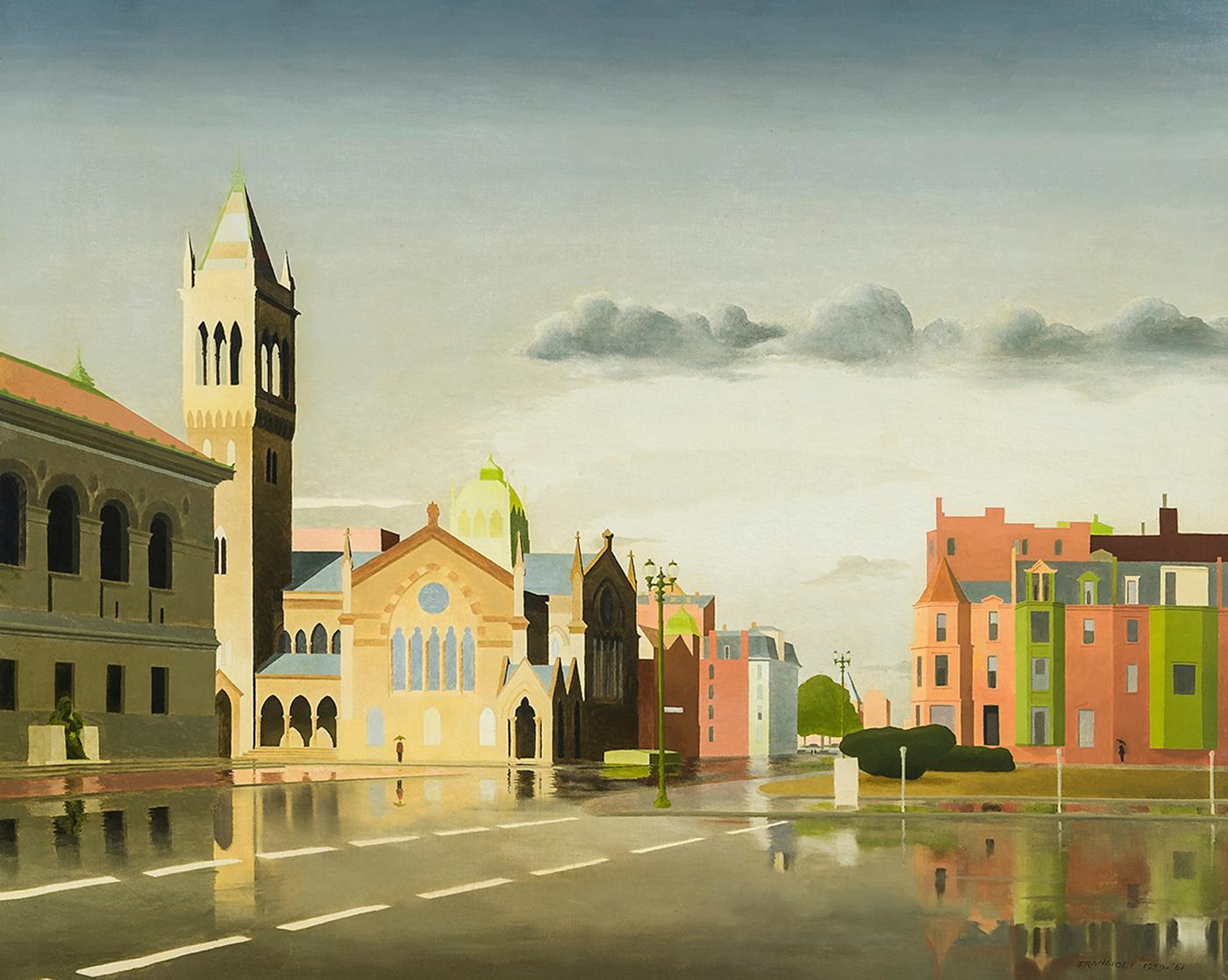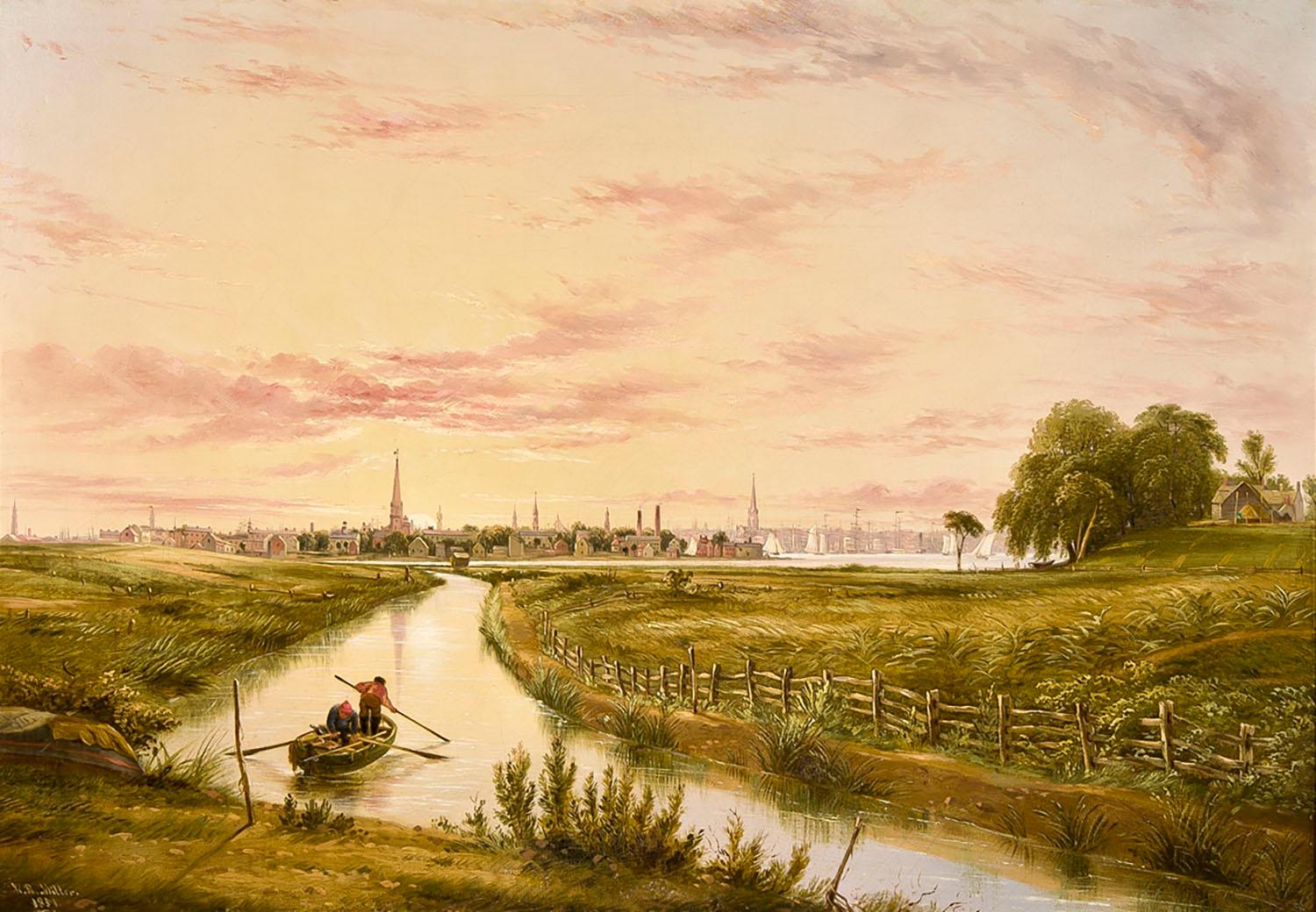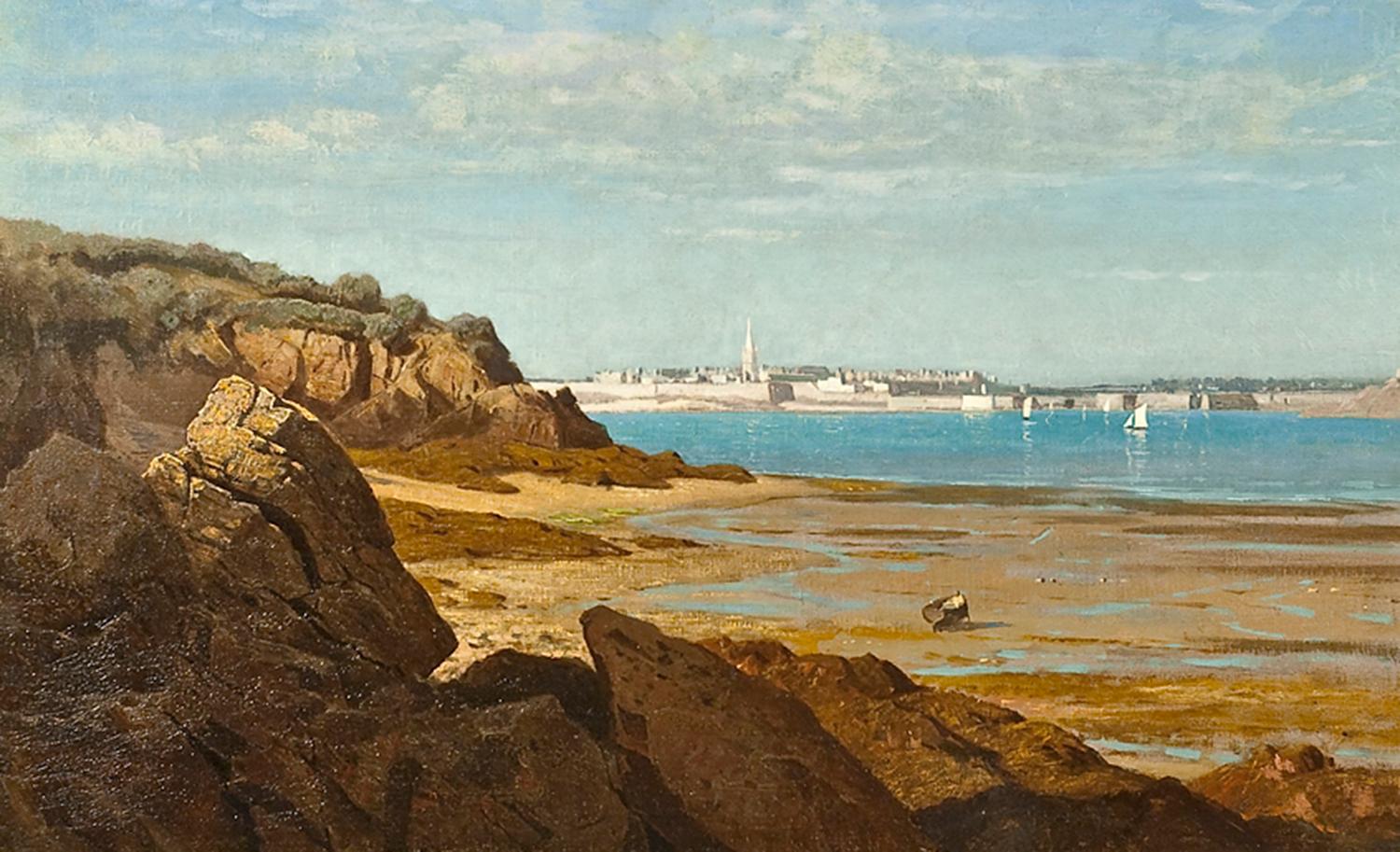Items Similar to Marina Grande, Capri
Want more images or videos?
Request additional images or videos from the seller
Charles Temple DixMarina Grande, Capri1866
1866
About the Item
Charles Temple Dix was born in Albany, New York, the youngest son of the distinguished statesman and soldier, General John Adams Dix. Having already visited Europe as a child, Dix returned with his family to Italy from 1853 to 1855. Dix’s decision to become an artist was enthusiastically supported by his father, and after graduation from Union College, Schenectady, New York, Dix continued his art studies in New York City in the late 1850s. Dix quickly immersed himself in the New York art world. He occupied a studio at the famous Tenth Street Studio building from 1860 to 1862, and he exhibited annually at the National Academy of Design, New York, from 1857 to 1861, the year in which he was elected an associate of that institution. He never submitted the diploma painting required for qualification as a full member.
Following the outbreak of the Civil War, Dix joined the Union army, serving as a major and acting as his father’s aide-de-camp. His creative output during this period was curtailed by his involvement in wartime activities. In March 1865, at the close of the war, Dix resumed his artistic career. He left for Europe, spending the winter in Rome and visiting England sometime thereafter. It appears that he remained for at least some time, for in 1867 he exhibited at the Royal Academy, London. In 1868, he married Camilla Ottilie Watson, niece of the art historian, Mrs. Anne Brownell Jameson, in London, and the married couple soon settled in Rome. In January 1873, Dix joined other American artists in Rome in signing a resolution mourning the death of the much-admired Hudson River School painter, John F. Kensett. Dix’s brief period in Rome ended two months later, when he died at the age of thirty-five of a sudden hemorrhage of the lungs.
In the course of his short and promising career, Dix had established himself as a popular and successful painter of marine subjects, and he was one of the few such painters to elicit praise regularly from contemporary critics. In his Book of the Artists (1867), Henry Tuckerman called Dix a painter “of rare promise and no inconsiderable performance in the sphere of marine landscape” (p. 552), an unfortunately ironic forecast of the artist’s brief career.
Beginning about 1866, when he first wintered in Rome, Dix painted a number of marine subjects of the island of Capri. The present picture dates from that winter, before Dix’s trip to England and his subsequent marriage and relocation to Rome. Dix evidently traveled to the island, returning to Rome with sketches of its coastal scenery. Located on the northern side of the island, the Marina Grande was the chief port on Capri. Dix frames the composition at right with the large, rocky cliffs characteristic of Capri’s coastline, while the sweep of the water opens to the left. Dix’s use of color is deep and clear, faithfully capturing the incomparable range of blues of the Mediterranean sea and sky. All of the elements of the picture—rocks, clouds, boats, and water—are treated with careful accuracy, reflecting a truth-to-nature aesthetic as espoused by the influential English critic, John Ruskin, and echoing similar concerns with the rocky coast landscape as fellow American marine artist, William Stanley Haseltine. Marina Grande, Capri is remarkable in that the artist was only twenty-eight years old when he painted it, and it leads one to speculate as to what Dix might have accomplished had he enjoyed a longer life and career.
- Creator:Charles Temple Dix (1838 - 1873, American)
- Creation Year:1866
- Dimensions:Height: 18.25 in (46.36 cm)Width: 30.25 in (76.84 cm)
- Medium:
- Movement & Style:
- Period:
- Condition:
- Gallery Location:New York, NY
- Reference Number:
About the Seller
5.0
Recognized Seller
These prestigious sellers are industry leaders and represent the highest echelon for item quality and design.
Established in 1952
1stDibs seller since 2010
32 sales on 1stDibs
Associations
Art Dealers Association of America
- ShippingRetrieving quote...Ships From: New York, NY
- Return PolicyThis item cannot be returned.
More From This SellerView All
- Strawberries Strewn on a Forest FloorBy William Mason BrownLocated in New York, NYWilliam Mason Brown was born in Troy, New York, where he studied for several years with local artists, including the leading portraitist there, Abel Buel Moore. In 1850, he moved to ...Category
19th Century American Realist Landscape Paintings
MaterialsCanvas, Oil
- Copley Square, BostonBy Thomas FransioliLocated in New York, NYThomas Fransioli’s cityscapes are crisp and tidy. Buildings stand in bold outline, trees are sharp, and saturated color permeates the scene. But Fransioli’s cities often lack one critical feature: people. His streets are largely deserted, save for the rare appearance of figure and the occasional black cat scurrying across pavement. Instead, humanity is implied. Magic Realism neatly characterizes Fransioli’s viewpoint. First applied to American art in the 1943 MoMA exhibition “American Realists and Magic Realists...Category
20th Century American Realist Landscape Paintings
MaterialsCanvas, Oil
- New York from HobokenBy William Rickarby MillerLocated in New York, NYSigned (at lower left): W.R. Miller/ 1851Category
Mid-19th Century American Realist Landscape Paintings
MaterialsCanvas, Oil
- Saint-Malo, BrittanyBy William Stanley HaseltineLocated in New York, NYThe career of William Stanley Haseltine spans the entire second half of the nineteenth century. During these years he witnessed the growth and decline of American landscape painting, the new concept of plein-air painting practiced by the Barbizon artists, and the revolutionary techniques of the French Impressionists, all of which had profound effects on the development of painting in the western world. Haseltine remained open to these new developments, selecting aspects of each and assimilating them into his work. What remained constant was his love of nature and his skill at rendering exactly what he saw. His views, at once precise and poetic, are, in effect, portraits of the many places he visited and the landscapes he loved. Haseltine was born in Philadelphia, the son of a prosperous businessman. In 1850, at the age of fifteen, he began his art studies with Paul Weber, a German artist who had settled in Philadelphia two years earlier. From Weber, Haseltine learned about Romanticism and the meticulous draftsmanship that characterized the German School. At the same time, Haseltine enrolled at the University of Pennsylvania, and took sketching trips around the Pennsylvania countryside, exploring areas along the Delaware and Susquehanna rivers. Following his sophomore year, Haseltine transferred to Harvard University. After graduating from Harvard in 1854, Haseltine returned to Philadelphia and resumed his studies with Weber. Although Weber encouraged Haseltine to continue his training in Europe, the elder Haseltine was reluctant to encourage his son to pursue a career as an artist. During the next year, Haseltine took various sketching trips along the Hudson River and produced a number of pictures, some of which were exhibited at the Pennsylvania Academy of the Fine Arts in the spring of 1855. Ultimately, having convinced his father that he should be allowed to study in Europe, Haseltine accompanied Weber to Düsseldorf. The Düsseldorf Academy was, during the 1850s, at the peak of its popularity among American artists. The Academy’s strict course of study emphasized the importance of accurate draftsmanship and a strong sense of professionalism. Landscape painting was the dominant department at the Düsseldorf Academy during this period, and the most famous landscape painter there was Andreas Achenbach, under whom Haseltine studied. Achenbach’s realistic style stressed close observation of form and detail, and reinforced much of what Haseltine had already learned. His Düsseldorf training remained an important influence on him for the rest of his life. At Düsseldorf, Haseltine became friendly with other American artists studying there, especially Emanuel Leutze, Worthington Whittredge, and Albert Bierstadt. They were constant companions, and in the spring and summer months took sketching trips together. In the summer of 1856 the group took a tour of the Rhine, Ahr, and Nahe valleys, continuing through the Swiss alps and over the Saint Gotthard Pass into northern Italy. The following summer Haseltine, Whittredge, and the painter John Irving returned to Switzerland and Italy, and this time continued on to Rome. Rome was a fertile ground for artists at mid-century. When Haseltine arrived in the fall of 1857, the American sculptors Harriet Hosmer, Chauncey B. Ives, Joseph Mozier, William Henry Rinehart...Category
19th Century American Realist Landscape Paintings
MaterialsCanvas, Oil
- At the SpringBy Joshua ShawLocated in New York, NYJoshua Shaw was a farmer’s son, born in Billingborough, Lincolnshire, and orphaned at the age of seven. After a boyhood of privation, he tried a number of occupations, until he finally apprenticed to a sign painter and found his métier. Shaw went to Manchester to study art, and by 1802 was in Bath, painting landscapes. In that year he began to exhibit his work at the Royal Academy in London. Essentially self-taught, Shaw achieved an impressive level of competence and versatility, producing portraits, floral compositions, still lifes, landscapes, and, cattle pieces. Shaw continued to send works for exhibition at the Royal Academy, the British Institution, and the Suffolk Street Gallery, all in London, until 1841. (Although Shaw is regularly mentioned and frequently illustrated in a host of general books on American art history, as well as included in numerous historical survey exhibitions, the only monographic study of this artist is Miriam Carroll Woods, “Joshua Shaw [1776–1860]: A Study of the Artist and his Paintings” [M.A. thesis, University of California at Los Angeles, 1971]. Apart from short biographical sketches in various dictionaries and museum collection catalogues, the two most interesting references, both contemporary, are John Sartain’s personal recollections in The Reminiscences of a Very Old Man, 1808–1897 [1899; reprint 1969] and an article in Scientific American from August 7, 1869, “Joshua Shaw, Artist and Inventor.” The article quotes extensively from an autobiographical document in the possession of Shaw’s grandson that Shaw prepared for William Dunlap...Category
19th Century American Realist Landscape Paintings
MaterialsCanvas, Oil
- Mt. Etna from TaorminaBy Thomas FransioliLocated in New York, NYThomas Fransioli, born in 1906 in Seattle, Washington, trained as an architect at the University of Pennsylvania. He worked as an architect before his service in World War II. Largel...Category
20th Century American Realist Landscape Paintings
MaterialsCanvas, Oil
You May Also Like
- "Snow Squals, Parmelee Farm"By Peter PoskasLocated in Lambertville, NJSigned Lower Left Poskas was born in Waterbury, Connecticut, a small industrial city set on the banks of the Naugatuck River. He was interested in art as a child, but on entering ...Category
20th Century American Realist Landscape Paintings
MaterialsCanvas, Oil
- Unbridled Glory Western Landscape Big Sky Cloudscape Original Oil PaintingBy Phil Bob BormanLocated in Whitefish, MT"Unbridled Glory" by Phil Bob Borman Original Oil Painting on Linen Canvas, 46" x 84", 60" x 98" Framed, Hanging Hardware included Phil Bob Borman is an accomplished painter and scu...Category
21st Century and Contemporary American Realist Landscape Paintings
MaterialsCanvas, Linen, Oil
- Moonlit Winter Landscape c. 1945By George MarinkoLocated in Franklin, MIA fine example of the artist's best realistic style. A haunting landscape.Category
1940s American Realist Landscape Paintings
MaterialsCanvas, Oil
- America 2017, New York, urban architecture, subtle colorBy Gregory FruxLocated in Brooklyn, NYOil on canvas Dr. Rowland S. Russell PhD. writes about his experience directly witnessing Greg's practice as a “plein air” artist: Whether he’s portraying quiet scenes from Brooklyn...Category
2010s American Realist Landscape Paintings
MaterialsOil, Canvas
- Liquid and SolidBy Maryann LucasLocated in Sag Harbor, NYAn oil painting of a rocky shoreline in Montauk, New York. Painted from life, on site. Framed dimensions: 22 x 31.75 inches Maryann Lucas lives and works in Sag Harbor. She is pri...Category
2010s American Realist Landscape Paintings
MaterialsCanvas, Oil
- Humphrey's CadillacBy Danny HellerLocated in Fairfield, CTHeller covers monumental and lesser-known works starting with Frank Lloyd Wright and tracing his design principles through his son Lloyd Wright, and students Richard Neutra, Rudolph ...Category
Early 2000s American Realist Landscape Paintings
MaterialsCanvas, Oil
Recently Viewed
View AllMore Ways To Browse
Antique Temple
Temple Italian
Married Couple
Capri Used
Charles March
English American Landscapes
Charles Child
Italian Capri
John Temple
Capri Art
Antique Boats Of America
Union Civil War
Union Army
1850s American
Landscape Painting With Soldiers
Marine Landscape Italy
Large European Landscape 19th Century
Landscape Painting By Adams





